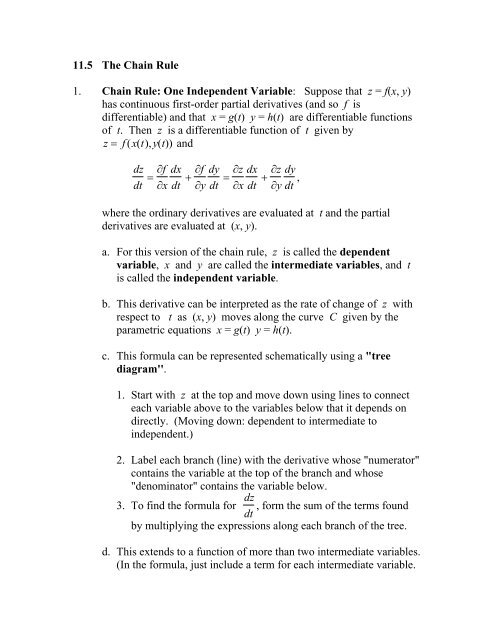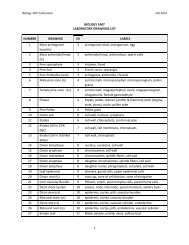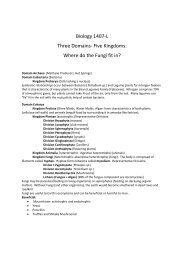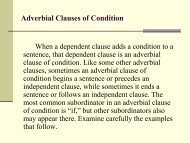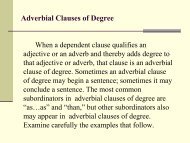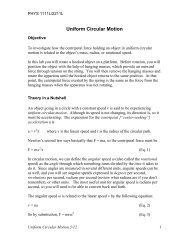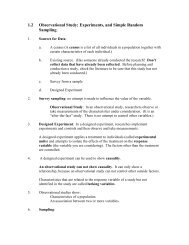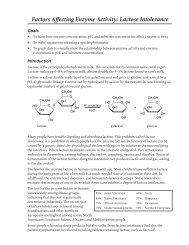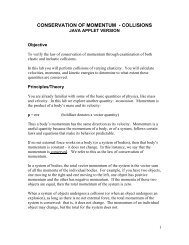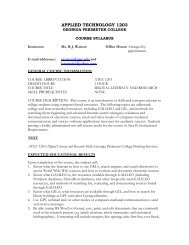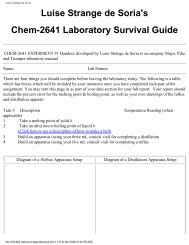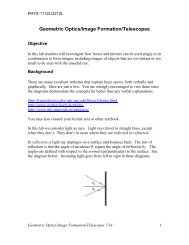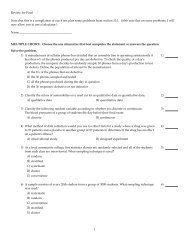z = f(x(t),y(t)) and , where the ordinary derivatives are evaluated at t ...
z = f(x(t),y(t)) and , where the ordinary derivatives are evaluated at t ...
z = f(x(t),y(t)) and , where the ordinary derivatives are evaluated at t ...
Create successful ePaper yourself
Turn your PDF publications into a flip-book with our unique Google optimized e-Paper software.
11.5 The Chain Rule<br />
1. Chain Rule: One Independent Variable: Suppose th<strong>at</strong> z = f(x, y)<br />
has continuous first-order partial <strong>deriv<strong>at</strong>ives</strong> (<strong>and</strong> so f is<br />
differentiable) <strong>and</strong> th<strong>at</strong> x = g(t) y = h(t) <strong>are</strong> differentiable functions<br />
of t. Then z is a differentiable function of t given by<br />
z = f (x(t), y(t)) <strong>and</strong><br />
dz<br />
dt = ∂f dx<br />
∂x dt + ∂f dy<br />
∂y dt = ∂z dx<br />
∂x dt + ∂z dy<br />
∂y dt ,<br />
<strong>where</strong> <strong>the</strong> <strong>ordinary</strong> <strong>deriv<strong>at</strong>ives</strong> <strong>are</strong> <strong>evalu<strong>at</strong>ed</strong> <strong>at</strong> t <strong>and</strong> <strong>the</strong> partial<br />
<strong>deriv<strong>at</strong>ives</strong> <strong>are</strong> <strong>evalu<strong>at</strong>ed</strong> <strong>at</strong> (x, y).<br />
a. For this version of <strong>the</strong> chain rule, z is called <strong>the</strong> dependent<br />
variable, x <strong>and</strong> y <strong>are</strong> called <strong>the</strong> intermedi<strong>at</strong>e variables, <strong>and</strong> t<br />
is called <strong>the</strong> independent variable.<br />
b. This deriv<strong>at</strong>ive can be interpreted as <strong>the</strong> r<strong>at</strong>e of change of z with<br />
respect to t as (x, y) moves along <strong>the</strong> curve C given by <strong>the</strong><br />
parametric equ<strong>at</strong>ions x = g(t) y = h(t).<br />
c. This formula can be represented schem<strong>at</strong>ically using a "tree<br />
diagram''.<br />
1. Start with z <strong>at</strong> <strong>the</strong> top <strong>and</strong> move down using lines to connect<br />
each variable above to <strong>the</strong> variables below th<strong>at</strong> it depends on<br />
directly. (Moving down: dependent to intermedi<strong>at</strong>e to<br />
independent.)<br />
2. Label each branch (line) with <strong>the</strong> deriv<strong>at</strong>ive whose "numer<strong>at</strong>or"<br />
contains <strong>the</strong> variable <strong>at</strong> <strong>the</strong> top of <strong>the</strong> branch <strong>and</strong> whose<br />
"denomin<strong>at</strong>or" contains <strong>the</strong> variable below.<br />
3. To find <strong>the</strong> formula for dz , form <strong>the</strong> sum of <strong>the</strong> terms found<br />
dt<br />
by multiplying <strong>the</strong> expressions along each branch of <strong>the</strong> tree.<br />
d. This extends to a function of more than two intermedi<strong>at</strong>e variables.<br />
(In <strong>the</strong> formula, just include a term for each intermedi<strong>at</strong>e variable.
In <strong>the</strong> tree diagram, include a branch for each intermedi<strong>at</strong>e<br />
variable.)<br />
e. This version of <strong>the</strong> chain rule has applic<strong>at</strong>ions to rel<strong>at</strong>ed r<strong>at</strong>es,<br />
<strong>where</strong> t is interpreted as time.<br />
2. Chain Rule: Two Independent Variables: Suppose th<strong>at</strong> z = f(x, y)<br />
has continuous first-order partial <strong>deriv<strong>at</strong>ives</strong> (<strong>and</strong> so f is<br />
differentiable) <strong>and</strong> th<strong>at</strong> x = g(s, t) y = h(s, t) <strong>are</strong> differentiable<br />
functions of s <strong>and</strong> t. Then z is a differentiable function of s <strong>and</strong> t<br />
given by z = f (x(s,t), y(s,t)) <strong>and</strong><br />
∂z<br />
∂s = ∂z ∂x<br />
∂x ∂s + ∂z ∂y<br />
∂y ∂s<br />
∂z<br />
∂t = ∂z ∂x<br />
∂x ∂t + ∂z ∂y<br />
∂y ∂t .<br />
a. Note th<strong>at</strong> in this case, <strong>the</strong>re <strong>are</strong> two independent variables.<br />
b. To prove hold one of <strong>the</strong> independent variables fixed <strong>and</strong><br />
differenti<strong>at</strong>e using <strong>the</strong> one independent variable case above.<br />
c. In <strong>the</strong> tree diagram, <strong>the</strong>re will be two branches below each of<br />
<strong>the</strong> intermedi<strong>at</strong>e variables, one for each independent variable.<br />
To find each partial deriv<strong>at</strong>ive of z, add <strong>the</strong> products of <strong>the</strong><br />
expressions along <strong>the</strong> branches th<strong>at</strong> end in <strong>the</strong> required<br />
independent variable.<br />
3. Chain Rule: The General Case: Suppose th<strong>at</strong> w is a differentiable<br />
function of <strong>the</strong> variables x 1 , x 2 , . . . , x m <strong>and</strong> th<strong>at</strong> each of <strong>the</strong>se<br />
variables is a differentiable function of <strong>the</strong> variables t 1 , t 2 , … , t n .<br />
Then,<br />
∂w<br />
∂w<br />
∂x1<br />
∂w<br />
∂x2<br />
∂w<br />
∂xm<br />
= + + L +<br />
∂t<br />
∂x<br />
∂t<br />
∂x<br />
∂t<br />
∂x<br />
∂t<br />
i<br />
for each i = 1,2,...,n.<br />
1<br />
i<br />
2<br />
i<br />
m<br />
i
(Note th<strong>at</strong> <strong>the</strong>re <strong>are</strong> as many terms in each partial of w as <strong>the</strong>re <strong>are</strong><br />
intermedi<strong>at</strong>e variables <strong>and</strong> as many partial <strong>deriv<strong>at</strong>ives</strong> of w as<br />
independent variables.)<br />
A tree diagram will have as many branches below w as intermedi<strong>at</strong>e<br />
variables <strong>and</strong> each of <strong>the</strong>se intermedi<strong>at</strong>e variables will have as many<br />
branches as it has independent variables.<br />
4. Implicit Differenti<strong>at</strong>ion: Suppose th<strong>at</strong> <strong>the</strong> function F(x, y) is<br />
differentiable (for example, it has continuous first partial <strong>deriv<strong>at</strong>ives</strong>)<br />
<strong>and</strong> th<strong>at</strong> <strong>the</strong> equ<strong>at</strong>ion F(x, y) = 0 implicitly defines a differentiable<br />
function y = f(x). Then <strong>the</strong> one independent variable case of <strong>the</strong><br />
chain rule gives<br />
∂F<br />
dy<br />
dx =− ∂x<br />
∂F<br />
∂y<br />
=− F x<br />
F y<br />
, <strong>where</strong> ∂F<br />
∂x ≠ 0.<br />
5. Implicit Function Theorem: If F is defined on a disk containing<br />
(a, b), <strong>where</strong> F(a, b) = 0, F y (a,b) ≠ 0, <strong>and</strong> F x <strong>and</strong> F y <strong>are</strong> both<br />
continuous on <strong>the</strong> disk, <strong>the</strong>n <strong>the</strong> equ<strong>at</strong>ion F(x, y) = 0, defines y as a<br />
function of x near <strong>the</strong> point (a, b) <strong>and</strong> <strong>the</strong> <strong>deriv<strong>at</strong>ives</strong> of this function<br />
<strong>are</strong> given by <strong>the</strong> deriv<strong>at</strong>ive given above in 4.<br />
6. Implicit Partial Differenti<strong>at</strong>ion: Suppose th<strong>at</strong> <strong>the</strong> function F(x, y, z)<br />
is differentiable (for example, it has continuous first partial<br />
<strong>deriv<strong>at</strong>ives</strong>) <strong>and</strong> th<strong>at</strong> <strong>the</strong> equ<strong>at</strong>ion F(x, y, z) = 0 implicitly defines a<br />
differentiable function z = f(x, y) (for example, it has continuous first<br />
partial <strong>deriv<strong>at</strong>ives</strong>). Then<br />
∂z<br />
∂x =−F x<br />
F z<br />
<strong>and</strong><br />
∂z<br />
∂y =−F y<br />
F z<br />
, were F z = ∂F<br />
∂z ≠ 0.<br />
7. Implicit Function Theorem: If F is defined on a sphere containing<br />
(a, b, c), <strong>where</strong> F(a, b, c) = 0, F y (a,b,c) ≠ 0 , <strong>and</strong> F x , F y , <strong>and</strong> F z <strong>are</strong><br />
both continuous inside <strong>the</strong> sphere, <strong>the</strong>n <strong>the</strong> equ<strong>at</strong>ion F(x, y, z) = 0,<br />
defines z as a function of x <strong>and</strong> y near <strong>the</strong> point (a, b, c) <strong>and</strong> <strong>the</strong><br />
partial <strong>deriv<strong>at</strong>ives</strong> <strong>are</strong> given by <strong>the</strong> deriv<strong>at</strong>ive given above in 6.


